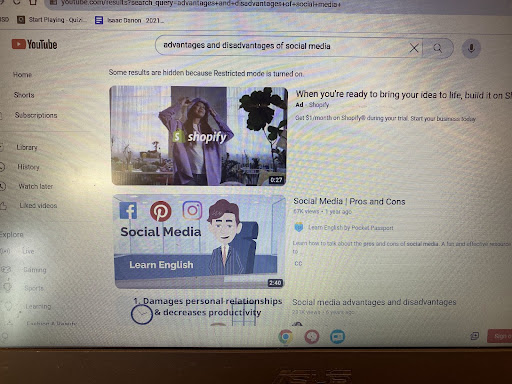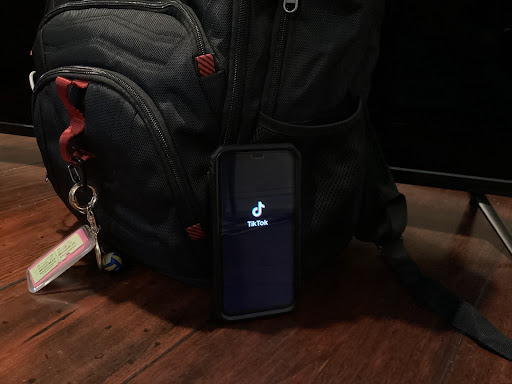When it comes to social media, most kids see it as an ability to instantly connect with others and share their personal content according to pewreserach.com. Most teens relate to virtual communities as a way to create and maintain relationships while being artistic and observant in the physical world according to pewresearch.com. However, teens also participate in its negative qualities, such as cyberbullying or having the urge to present themselves to the camera in a certain way.
“You can learn a lot of good things about social media, but you can use it to cause a lot of harm,” said Sage Creek High School junior Logan Rangel.
When exploring the internet, social media can be seen as an instrument that unleashes both beneficial and harmful consequences.
“I think, like most things, social media offers positives and negatives,” said Ms. Williams, Sage Creek’s AP Psychology and AP United States History (APUSH) teacher.
There are many positive aspects of social media when it comes to social connectivity, but there is also a hidden dark side.
“Social media can be a great outlet and way to connect with friends and family. ” said Bob Boeckman, Sage Creek’s school therapist. “Social media can also have negative effects; it can lead to feeling inferior and ultimately less connected.”
In terms of benefits, social media has a significant impact on everyday routines due to its set of digital techniques regarding technology. According to digital citizenship.nsw.edu.au, social media can assist kids with their digital skills in developing and maintaining online identities. It can also help them guide through the rest of the social media world.
For teenagers, social media platforms foster online community relationships with group chats, live videos and other forms of online social interaction.
“Social media can be a great convenient way for people to stay connected even if geographically not close,” Boeckman said.
Individuals can develop their critical thinking skills by identifying trusted sources of information and teaching young individuals to question the reliability of those sources. Furthermore, social media can help youth create online identities as a method to explore other aspects of their interests that aren’t available offline.
“It gives you the advantage to show your face online, chat with your friends, and post whatever you like,” said senior Josh Salerno.

However, social media can also carry a number of disadvantages.
According to the CDC, not all people trust social media with their personal information as many individuals aren’t familiar with its capabilities. A true fact is that social media is the backbone for online flashfires, cyber attacks and many more incidents.
For online information, most sources aren’t expected to be accurate or honest, which creates rumors and spreads biased data. In other words, social media posts and videos are mostly fake news.
“It can lead to the spread of misinformation,” Williams mentioned.
Social media is also known for generating anxiety among social media users when scrambling to come up with the perfect image or video.
“People regularly post their highs on social media, but in real life, they may be struggling just as much as anyone else,” Boeckman said.
Also, Social media can contain negative mental health effects.
According to webtrainings.in, studies convey that people who spend too much time on social media have trouble sleeping, which can lead to sleeping disorders. Social media can also lead to a Fear of Missing out, or “FOMO,” as many people are anxiously checking their phones for new updates and messages, leading to stress and unease.
Too much time on social media is one of the leading factors that pushes people to depression. Getting too preoccupied with someone’s life can throw people into a period of misery.
“You can think you’re talking to someone, but behind the screen you don’t know,” Rangel noted.
There are a lot of common privacy issues on social media, such as data mining, cyberstalking, online footprints and especially hacking and account takeovers. The more information users put online, the more they are putting their identity, assets and their lives in danger.
“Social media is also a way predators use to connect with children for trafficking purposes or sexploitation,” Williams added. “My biggest concern is that it can create isolation and a lack of real-life connections.”
For communication skills, social media can decrease them as it makes people less empathetic and more self-centered. Narcissism is common on social media, as most individuals can brag about their achievements and post photos from parties without facing the consequences.
“Social media can lead to comparisons, which often leave people feeling less satisfied with their lives,” Williams said. “It can lead to unrealistic expectations of physical appearances.”
Overall, social media can have a mix of beneficial and detrimental consequences on an individual’s mindset including their communication skills.
“My first suggestion is that students, and their parents, should educate themselves about the platform they want to use before they use it,” Williams said.

Social media can be a complex and unfamiliar world for teens and kids who aren’t aware of its abilities, communications and outcomes.
“Whatever you post on the internet, stays on the internet forever,” said Salerno.
Teachers should teach Sage Creek to be more mindful of social media. Teaching individuals how to use social media will help them recognize risks while enjoying the benefits that these platforms have to offer.
“I would recommend monitoring your own use and monitoring how it makes you feel,” Boeckman advised.
Social media time limits would encourage students to engage in moderate social media use and assist teens with self-control.
“I would advise students to do the right thing,” Rangel advised. “One bad post, and one bad decision could ruin their life and their career.”









